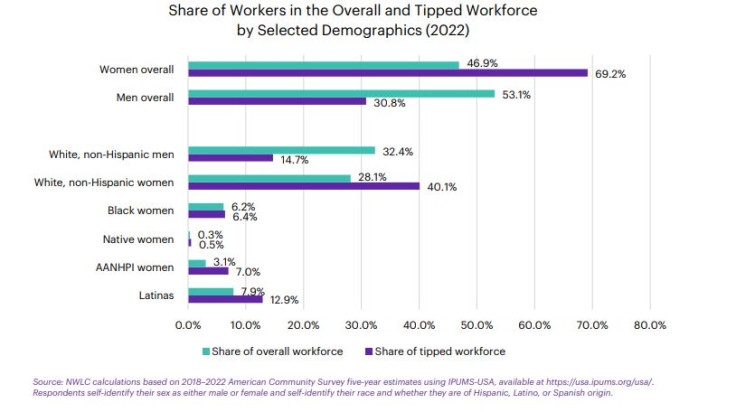
More than one third of all Latina tipped workers live close to the poverty line, while 10.9% are indeed poor, a report by the National Women's Law Center (NWLC) showed.
The study, titled "One Fair Wage: Women Fair Better in States with Equal Treatment for Tipped Workers," says Latinas face "disproportionately high poverty rates due to stagnant minimum wage policies."
While the federal minimum wage has remained at $7.25 an hour since 2009, tipped workers such as restaurant servers and bartenders can see even lower wages, the document points out.
"For more than three decades, federal law has allowed employers to pay tipped workers a 'tipped minimum cash wage' of only $2.13 per hour before tips. Although employers are required to ensure that their tipped workers receive at least the regular minimum wage by making up the difference when tips fall short, this requirement is difficult to enforce and many employers fail to comply," the report states.
The poverty rate for tipped workers at the national level (10.3%) is more than double the rate for workers overall, according to data highlighted in the report.
Some 33.9% of Latina tipped employees live near the poverty line, compared with 24.4% of non-Hispanic whites, the report found.

The study also sheds light on how Latinas are significantly overrepresented in the tipped workforce.
NWLC calculations, which is based on 2018–2022 American Community Survey, found that while women make up 46.9% of the overall workforce in the United States, they represent 69.2% of the tipped workforce. In comparison, men represent 53.1% of the overall workforce, but only 30.8% of the tipped workforce.
Looking at women in particular, Latinas, along with Asian American and Native Hawaiian/Pacific Islander (AANHPI) women and white non-Hispanic women, are significantly overrepresented in the tipped workforce.
According to the fact sheet, Latinas make up 7.9% of the total U.S. workforce, but 12.9% of the tipped workforce. This gap is only larger for AANHPI women (3.1% to 7%).
Their incomes vary considerably by state. The report highlights that seven "One Fair Wage" states—Alaska, California, Minnesota, Montana, Nevada, Oregon, and Washington—require employers to pay tipped workers the regular state minimum wage before tips.
Compared to states with a $2.13 tipped minimum wage and in-between states, tipped female workers in One Fair Wage states experience lower poverty rates, higher median annual earnings for tipped workers, and a smaller gender wage gap for all workers, the document outlines.
"Raising minimum wages for all working people has outsized benefits for women and their families, reducing poverty for all and helping to close the gender wage gap. Ensuring that tipped workers can count on receiving a full and fair minimum wage, before tips, is a crucial step toward equality, dignity, and safety for women at work," the National Women's Law Center concludes.
© 2025 Latin Times. All rights reserved. Do not reproduce without permission.





